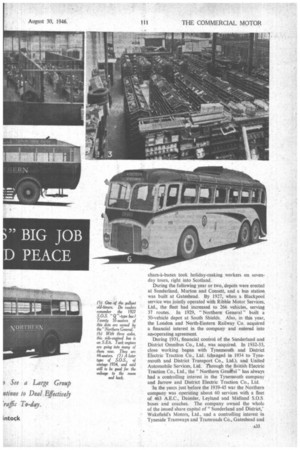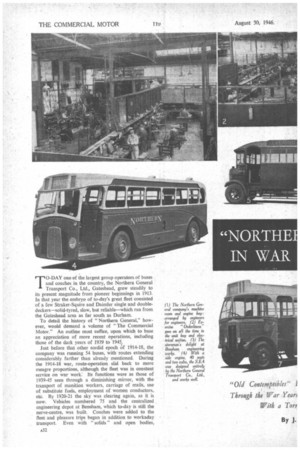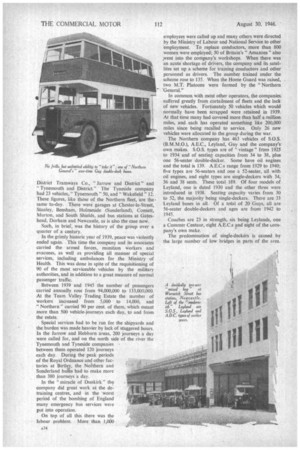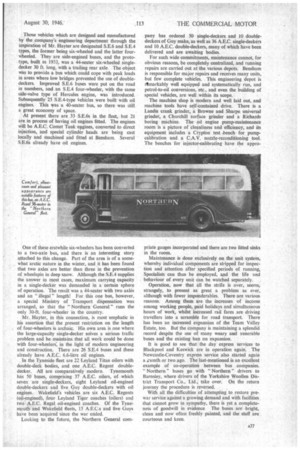" BIG JOB D PEACE
Page 35

Page 34

Page 36

Page 39

If you've noticed an error in this article please click here to report it so we can fix it.
TO-DAY one of the largest group operators of buses and coaches in the country, the Northern General Transport Co., Ltd., Gateshead, grew steadily to its present magnitude from pioneer beginnings in 1913. In that year the embryo of to-day's great fleet consisted of a few Straker-Squire and Daimler single and doubledeckers—solid-tyred, slow, but reliable—which ran from the Gateshead area as far south as Durham.
To detail the history of "Northern General," however, would demand a volume of "The Commercial Motor." An outline must suffice, upon which to base an appreciation of more recent operations, including those of the dark years of /939 to 1945.. Just before that other sordid epoch of 1914-18, the company was running 54 buses, with routes extending considerably farther than already mentioned. During the 1914-18 war, route-operation slid back to more meagre proportions, although the fleet was in constant service on war work. Its functions were as those of 1939-45 seen through a diminishing mirror, with the transport of munition workers, carriage of mails, use of substitute fuels, employment of women conductors, etc. By 1920-21 the sky was clearing again, as it is now. Vehicles numbered 75 and the centralized engineering depot at Berrsham, which to-day is still the nerve-centre, was built. Coaches were added to the fleet and pleasure trips began in addition to workaday transport. Even with " solids " and open bodies,
chars-à-banes took holiday-making workers on sevenday tours, right into Scotland.
During the following year or two, depots were erected at Sunderland, Murton and Consett, and a bus station was built at Gateshead. By 1927, when a Blackpool service was jointly operated with Ribble Motor Services, Ltd., the fleet had increased to 266 vehicles, serving 37 routes. In 1929, "Northern General" built a 50-vehicle depot at South Shields. Also, in this year, the London and North-Eastern Railway Co. acquired a financial interest in the company and entered into an•operating agreement. During 1931, financial control of the Sunderland and District Omnibus Co., Ltd., was acquired. In 1932-33, close working began with Tynemouth and District Electric Traction Co., Ltd. (changed in 1934 to Tynemouth and District Transport Co., Ltd.), and United Automobile Services, Ltd. Through the British Electric Traction Co., Ltd., the "Northern Gentfal " has always had a controlling interest in the Tynernouth company and Jarrow and District Electric Traction Co., Ltd.
in the years just before the 1939-45 war the Northern company was operating about 60 services with a fleet of 463 AEC., Daimler, Leyland and Midland S.O.S. buses and coaches. The company owned the whole of the issued share capital of " Sunderland and District," Wakefield's Motors, Ltd., and a controlling interest in Tyneside Tramways and Tranaroads Co., Gateshead and
District Tramways Co., "Jarrow and District" and Tynemouth and District." The Tyneside company had 23 vehicles, " Tynemouth " 50, and "Wakefield" 12. These figures, like those of the Northern fleet, are the same to-day. There were garages at Chester-le-Street, Stanley, Bensham, Holmeside (Sunderland), Consett, Murton, and South Shields, and bus stations at Gateshead, Durham and Newcastle, as is also the case now.
Such, in brief, was the history of the group over a quarter of a century.
In the grimly historic year of 1939, peace was violently ended again. This time the company and its associates carried the armed forces, munition workers and evacuees, as well as providing all manner of special services, including ambulances for the Ministry of Health. This was done in spite of the requisitioning of 90 of the most serviceable vehicles by the military authorities, and in addition to a great measure of normal passenger traffic.
Between 1939 and 3945 the number of passengers carried annually rose from 94,000,000 to 133,000,000. At the Team Valley Trading Estate the number of workers increased from 5,000 to 14,000, and "Northern " carried 90 per cent. of them, which meant more than 500 vehicle-journeys each day, to and from the estate.
Special services had to be run for the shipyards and the burden was made heavier by lack of staggered hours. In the Jarrow and Hebburn areas, 200 journeys a day were called for, and on the north side of the river the Tynemouth and Tyneside companies between them operated 120 journeys each day. During the peak periods of the Royal Ordnance and other factories at Birtley, the Nofthern and Sunderland buns had to make more than 380 journeys a day.
In the "miracle of Dunkirk" the company did great work at the detraining centres, and in the worst period of the bombing of England many emergency bus services were put into operation.
On top of all this there was the labour problem.. More than 1,000 employees were called up and many others were directed by the Ministry of Labour and National Service to other employment. To replace conductors, more than 800 women were employed; 50 of Britain's " Amazons " also ;went into the company's workshops. When there was an acute shortage of drivers, the company and its satellites set up a scheme for training conductors and other personnel as drivers. The number trained under the scheme rose to 135. When the Home Guard was raised, two M.T. Platoons were formed by the "Northern -General."
In common with most other operators, the companies suffered greatly from curtailment of fleets and the lack of new vehicles. Fortunately 50 vehicles which would normally have been scrapped were retained in 1939. At that time many had covered more than half a million miles, and each has operated something like 200,000 miles since being recalled to service. Only 26 new vehicles were allocated to the group during the war.
The Northern company has 463 vehicles of S.O.S. (13.M.M.0.), A.E.C., Leyland, Guy and the company's own makes. S.O.S. types are of "vintage" from 1925 to 1934 and of seating capacities from 34 to 38, plus one 56-seater double-decker. Sonic have oil engines and the total is 139. A.E.C.s range from 1929 to 1940; five types are 56-seaters and one a 52-seater, all with oil engines, and eight types are single-deckers with 34, 36 and 38 seats. These total 189. Of four models of Leyland, one is dated 1930 and the other three were introduced in 1938. Seating capacity varies from 30 to 52, the majority being single-deckers. There are 33 Leyland buses in all. Of a total of 20 Guys, all are 56-seater double-deckers and ages are from 1942 to 1945.
Coaches are 23 in strength, six being Leylands, one a Commer Centaur, eight A.E.C.s and eight of the company's own make, The predomination of single-deckers is caused by the large number of low bridges in parts of the area Those vehicles which are designed and manufactured by the company's engineering department through the inspiration of Mr. Hayter are designated S.E.6 and S.E.4 types, the former being six-wheeled and the latter fourwheeled. They are side-engined buses, and the prototype, built in 1933, was a 44-seater six-wheeled singledecker 30 ft. long, with a trailing rear axle. The object was to provide a bus which could cope with peak loads in areas where low bridges prevented the use of doubledeckers. improved S.E.6 buses were put on the road in numbers, and an S.E.4 four-wheeler, with the same side-valve type of Hercules engine, was introduced. Subsequently 25 S.E.4-type Vehicles were built with oil engines. This was a 40-seater bus, so there was still a great economy of space.
At present there are 33 S.E.6s in the fleet, but 21 are in process of having oil engines fitted. The engines will be A.E.C. Comet Tank mines, converted to direct injection, and special cylinder heads are being cast locally and machined and fitted at Bensham. Several S.E.6s already have oil engines. pany has ordered 50 single-deckers and 10 doubledeckers of Guy make, as well as 36 A.E.C. single-deckers and 10 A.E.C. double-deckers, many of which have been delivered and are awaiting bodies.
For such wide commitments, maintenance cannot, for obvious reasons, be completely centralized, and running repairs are carried out at the various depots. Bensham is responsible for major repairs and receives many units, but few complete vehicles. This engineering depot is rtmarkably well equipped and systematically run, and petrol-to-oil conversions, etc., and even the building of special vehicles, are well within its scope.
The machine shop is modern and well laid out, and machine tools have self-contained drive. There is a Landis crank grinder, a Browne and Sharpe universal grinder, a Churchill surface grinder and a Richards boring machine. The oil engine pump-maintenance room is a picture of cleanliness and efficiency, and its equipment includes a Crypton test bench for pumpcalibration and a C.A.V. nozzle-reconditioning tool. The benches for injector-calibrating have the appro One of these erstwhile six-wheelers has been converted to a two-axle bus, and there is an interesting story attached to this change. Part of the area is of a somewhat arctic nature in the winter, and it has been found that two axles are better than three in the prevention of wheelspin in deep snow. Although the S.E.4 supplies the answer in most cases, maximum carrying capacity in a single-decker was demanded in a certain sphere of operation. The result was a 44-seater with two axles and an " illegal " length! For this one bus, however, a special Ministry of Transport dispensation was arranged, so that the "Northern General" runs the only 30-ft. four-wheeler in the country.
Mr. Hayter, in this connection, is most emphatic in his assertion that the present restriction on the length of four-wheelers is archaic. His own area is one where the large-capacity single-decker solves a serious traffic problem and he maintains that all work could be done with four-wheelers; in the light of modern engineering and construction. There are 26 S.E.4 buses and these already have A.E.C. 6.6-litre oil engines.
In the Tyneside fleet are 22 Leyland Titan oilers with double-deck bodies, and one A.E.C. Regent doubledecker. All are comparatively modern. Tynemouth has 50 buses, comprising 37 A.E.C. oilers, of which seven are single-deckers, eight Leyland oil-engined double-deckers and five Guy double-deckers with oil engines. Wakefield's vehicles are six A.E.C. Regents (oil-engined), four Leyland Tiger coaches (oilers) and two A.E.C. Regal oil-engined coaches. Of the Tynemouth and Wakefield fleets, 15 A.E.C.s and five Guys have been acquired since the war ended.
Looking to the future, the Northern General corn priate gauges incorporated and there are two fitted sinks in the room.
Maintenance is done exclusively on the unit system, whereby individual components are stripped for inspection and attention after specified periods of running, Specialists can thus be employed, and the life and behaviour of every unit can be watched separately.
Operation, now that all the strife is over, seems, strangely, to present as great a problem as ever, although with fewer imponderables. There are various reasons. Among them are the increases of income among working people, paid holidays and simultaneous hours of work, whilst increased rail fares are driving travellers into a scramble for road transport. There has been an increased expansion of the Team Valley Estate, too. But the company is maintaining a splendid record despite the use of many weary and venerable buses and the existing ban on expansion.
It is good to see that the day express services to Blackpool and Keswick are in operation again. The Newcastle-Coventry express service also started again a zionth or two ago. The last-mentioned is an excellent example of co-operation between bus companies. " Northern " buses go with " Northern " drivers to Barnsley, where drivers of the Yorkshire Woollen District Transport Co., Ltd., take over. On the return journey the procedure is reversed.
With all the difficulties of attempting to restore prewar service against a growing demand and with facilities that cannot grow in sympathy, there is yet a completeness of goodwill in evidence The buses are bright, clean and now often freshly painted, and the staff are courteous and keen.




































































